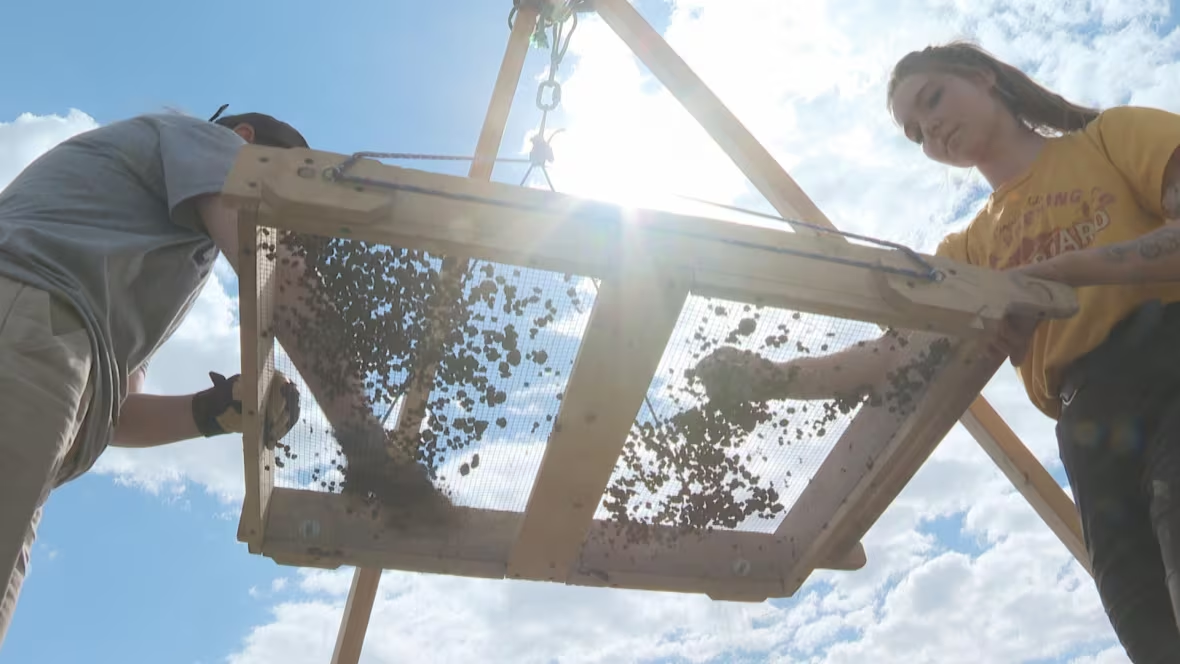Students learn to conduct archeology in respectful way on Siksika reserve
'Archeology as a discipline has a very colonial history,' says U of C instructor
A team of young archeologists is busy at work at the south camp archeological site on the Siksika First Nation in central Alberta.
The University of Calgary, in partnership with Old Sun Community College, is working with Siksika elders and community members in its archeological excavation at the south camp site.
"Archeology as a discipline has a very colonial history," said Lindsay Amundsen-Meyer, an archeology instructor at the University of Calgary, who has been working on the excavation.
Amundsen-Meyer said working with members of the Siksika First Nation was important to ensure this dig was done with, for and by Indigenous people.

Before the team began digging, Amundsen-Meyer's team attended a beaver bundle ceremony, where Siksika elders prayed for their ancestors and the work about to be done. She said elders from the community came out every week to share stories with her team.
The excavation is meant to build capacity for archeological skills within the Siksika First Nation, Amundsen-Meyer said. She also hopes this excavation will teach non-Indigenous students from the U of C how to conduct archeology in a respectful way.
Megan Jerry is a band member and student at Old Sun Community College, which is operated by the First Nation. She said she joined the dig because she wanted to help bridge the gap between Western archeology practices and Indigenous cultures.
Jerry said she's learned a great deal while working on the excavation, including how patient archeologists need to be. She said finding artifacts at the site is "a special feeling."

"It just makes my heart feel full just holding these artifacts and seeing them first-hand and also just sharing them with the elders in the community. You know, they can feel that connection with these artifacts and I can feel it myself," Jerry said.
"We are still here. We're still strong people, and the fact that we're still finding things in this area is just fascinating."
Digging deeper
Amundsen-Meyer said one of the goals of this year's excavation was to find how deep the team could dig and continue to find artifacts at the site.
In 2020, her team found the base of a spear point in the area that could possibly be 10,000 years old, she said. While they aren't certain of its age, the discovery of the spear point made the team want to dig deeper.
Allie Bradford, a U of C student entering her fourth year, said the experience of working on this dig with the Siksika First Nation has been "eyeopening."
"Everything that I've taken so far in school has been through a Western lens," said Bradford.

She said the experience of getting to work at an actual archeological site was also a nice break from the academic side of things.
When our people learn that process of archeology, it strengthens our connection to this place.- Kent Ayoungman, Siksika Nation councillor
Kent Ayoungman, who sits on Siksika Nation council, spent time with the archeology team to share stories from his community. He said giving the team greater context about the land allows them to better understand the work they're doing on the Siksika reserve.
"Our stories go back a long way," he said.
Ayoungman said he's happy that members of his community are learning excavation skills through this project.
"When our people learn that process of archeology, it strengthens our connection to this place," he said.
"By seeing these artifacts, it's helping us to continue to see the importance of our stories today and preserve them and teach them to the future."
With files from Terri Trembath and James Young
